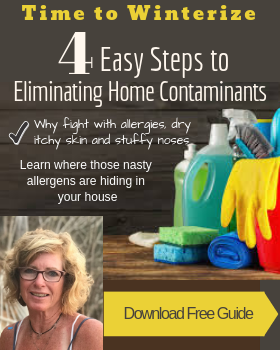Even though you can’t see it, the air you breathe can affect your health.
It’s that time of year when we begin to hibernate in our homes more; when temperatures are cooler and days shorter. It also tends to be when we become sick more often. The build-up of air pollutants inside our home could partly be to blame.
We all face a variety of risks as we go about our day-to-day lives. We encounter environmental pollutants outside every day by driving our car, flying in planes, and participating in recreational activities all pose a degree of risk. Some risks are unavoidable.
The air quality inside our homes is essential and a risk we can control. Sources of indoor air pollution can be identified, monitored and eliminated to control home contaminants and allergens.
To prepare your home, apartment or dorm room for winter, download my 4 Easy Steps to Eliminating Home Contaminants from the banner, either right or below this post. You’ll also learn 10 Ways to Fight those nasty Allergens as a bonus and where their hiding in your home.
With the change of seasons and cooling weather upon us, it becomes increasingly important to be vigilant to protect our health.
During the warmer months, we enjoy opening the windows to let in fresh air; it’s easier to ventilate our home. Conversely, during colder months, we tend to limit the amount of cold air circulating so we stay comfortable. I get it! There’s a fine line between allowing fresh air in and conserving your pocketbook when the heating bill arrives. Ugh!
Symptoms of Exposure

What Causes Poor Air Quality?
There are a variety of indoor sources of gases or particles that contribute to poor indoor air quality. Some sources such as building materials, furniture, and air fresheners continuously release pollutants; poor ventilation; lack of enough outdoor air to enter the home to dilute pollutant buildup; and high temperatures and humidity can also increase concentrations of contaminants.
Every winter, it seems, the news reports a story about the number of deaths from carbon monoxide poisoning or smoke inhalation from cooking due to lack of enough ventilation. Not to mention, the number of deaths of children ingesting toxic household cleaners.

There are three (3) strategies for keeping a healthy home:
- Eliminate the individual sources of indoor pollution or to reduce their emission
- Improve ventilation by opening doors and windows or operating window or attic fans
- Use table-top or whole-house air cleaners (Note: air cleaners are not designed to remove gaseous pollutants)
How to Bring Outdoor Air Inside Our House
There are three main ways outside air enters and leaves by:
- Infiltration meaning by openings, cracks, joints, floor, ceilings, and around windows and doors
- Natural Ventilation moves through windows and doors by air temperature differences from outdoors to indoors and by wind
- Mechanism Ventilation through outdoor-vented fans found in bathrooms and kitchen or by air handling systems by use of fans and ductwork such as your furnace or air conditioner
Reaction to Indoor Air Pollution
The immediate reaction to indoor air pollution depends on several factors:
- age and preexisting medical conditions are two critical influencers
- individual sensitivity
Effects
Individual reactions can be more immediate with similar symptoms to colds or other viral diseases. If symptoms fade or go away when away from home and reappear when the person returns; or effects made worse by an inadequate supply of outdoor air or from heating, cooling or humidity in the house.
Consider if symptoms occurred after you have recently moved to a new residence, remodeled or refinished a home or use of home pesticides, consult with a physician. Your symptoms may be related to your home environment.
Reference: US Consumers Product Safety Commission, “The Inside Story: A Guide to Indoor Air Quality“










Facebook Comments